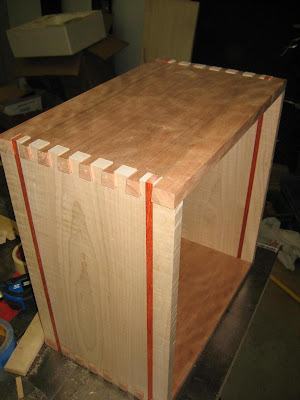This is another amp I'm working on. It will have 2 - 12AX7
Pre Amp Tubes with a cascade switch that will cascade the gain of the first tube into the 2
nd tube for more gain. It will also have an active (Send-Return) effects loop. The Effects loop will also have a switch to allow it to cascade into the
pre-amp section. The output tube is a 12AU7 so it should put out about 1 Watt.
This is the custom chassis I made for it. It's about 10.5" wide.

I used a laser to make 2 of these Acrylic turret boards that has a bunch of holes in them. I can then place the turrets in the holes and then fit the components. It makes designing a custom turret board a lot easier. Once I have the design figured out, I place the second on top of the actual fiberglass turret board. I then use a marker to mark the corresponding hole locations, transposing them from my design board. All the holes are numbered which makes it easy.

Today I started out with a small sheet of 20"x30" x 1/2" Baltic Birch Plywood. About $15.
It's about 10am.
I then spent a few minutes designing the cabinet on paper. Then got to cutting the sides.
The Speaker cab is about 12" wide and 13" tall and 8" deep. The Tolex covering comes in 54" width and I bought a yard of it for this amp. I will be able to use the 54" width to cover the cab. I wanted to be able to do the whole amp using just 1 yard of material.
I'm using 3/4" Marine Plywood for the speaker baffle. This plywood doesn't have any voids to affect the sound. The 3/4" is really thick for such a small speaker so it should be very efficient.
This is a scrap
piece of wood that I'm using to create a Router Template to cut out a perfectly round speaker hole. I drilled a pilot hole for my router bit to stick through. I then clamped the larger sheet to the router table.

Next, I simply rotate the top
piece. The Nail in the center is the axis. Thus it makes a perfectly round hole in my scrap wood.

I rough cut an opening in the speaker baffle using a jig saw. Next, I nailed my scrap template onto my speaker baffle. Inserted a 1/2" flush cut router bit. The top bearing will follow the perfectly round template thus making a perfectly round hole in my speaker baffle. I can then re-use this template over and over to make more speaker baffles.
Here is the speaker, it's an Italian Jensen 8" Guitar speaker.
Here's the head and speaker cabinet all glued and nailed together. It's lunch time 12:30pm , so I went to have a Taco at Armadillo Grill in Chapel Hill while the glue dried a bit.
The Chrome Corner protectors I will be using require a 1/2" radius. I came back and added some trim to the front. This adds some material so I can use a 1/2" Radius round over bit.
Finished the carpentry, and it's only 2:30pm. So about 4.5 hours start to finish here.

Tomorrow will be covering it with Tolex day!
 One down 3 more to go. This was quite a workout bending shaping the metal to get a nice matching round radius.
One down 3 more to go. This was quite a workout bending shaping the metal to get a nice matching round radius.






























































